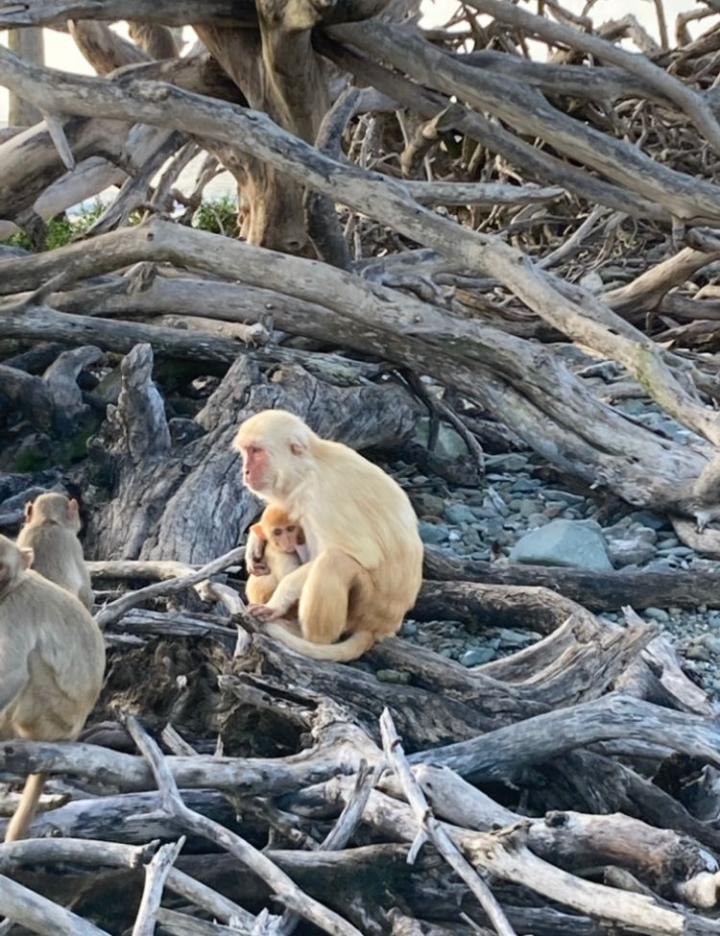Findings underscore evolutionary nature of non-verbal communication

Credit: James P. Higham
Non-parents expand the range of their facial expressions in caring for infants among primates, a team of anthropologists has found. The study shows the ability, among non-relatives, to both decipher facial expressions and to be attuned to others’ emotional states, revealing the evolutionary nature of communication.
The research, which appears in the journal Evolution, focused on the relationship between alloparenting, or infant care by non-parents, and the adoption of detailed facial expressions across more than 30 species of primates.
“Our results confirm previous work indicating that facial expressions facilitate communication between individuals living in larger social groups,” says Paola Cerrito, a doctoral candidate in NYU’s Department of Anthropology and College of Dentistry and an author of the paper. “But, this is the first study to demonstrate that the frequency of infant care by non-parents further predicts the ability to produce complex facial expressions across primate species.”
Speaking to the larger significance of the study, Alex DeCasien, a doctoral candidate in NYU’s Department of Anthropology and an author of the paper, adds, “Successful infant care by individuals other than the mother–such as the father, siblings, a babysitter, and other relatives–relies heavily on facial expressions. It is through this form of nonverbal communication that caregivers can understand the needs of infants and also coordinate care amongst themselves, thus enabling them to provide appropriate and effective infant care.”
The adaptive value of facial expressions has been debated in evolutionary biology ever since Darwin’s seminal work, The Expression of Emotion in Man and Other Animals (1872). It’s been long established that primates, including humans, exhibit the most intricate facial displays. And while earlier scholarship has focused on the role of social interaction in the evolution of primate facial expressions, this relationship had not been verified in a wide sample of species.
In the Evolution paper, Cerrito and DeCasien studied the relationship between the frequency of alloparental care and selected orofacial brainstem nuclei–the parts of the brain that control most of the muscles from the eyes down to the neck–using existing and newly collected databases on primate behavior.
The researchers hypothesized that the frequency of infant care by individuals other than the parents predicts facial musculature dexterity–the ability to produce intricate facial expressions.
Consistent with their hypothesis, the results showed that, across the studied species, increased facial dexterity was positively correlated with the frequency of alloparental care. Notably, however, these relationships were not found with paternal care, suggesting that fathers may, similarly to mothers, rely on hormonal changes to help them become attuned to the infants’ needs.
“How do adults attune themselves to the needs of slow-developing, helpless offspring?” Cerrito asks. “Mothers, across mammalian species, are hormonally primed, but what about others? Our work suggests that non-parents achieve this via facial expressions, but it appears that fathers don’t. So after looking at our results, we tried to make sense of them and discovered a significant body of literature indicating that males caring for their offspring also undergo hormonal changes. Our conclusion is that they use the same adaptive strategy as mothers, only mediated by different hormones.”
“Overall, this work suggests that alloparenting requires increased facial dexterity to facilitate nonverbal communication between infants and their non-parent caregivers,” adds Cerrito. “Accordingly, alloparenting and complex facial expressions are likely to have co-evolved in primates.”
###
Images are available on Google Drive:
https:/
DOI: 10.1111/evo.14275
Media Contact
James Devitt
[email protected]
Original Source
https:/
Related Journal Article
http://dx.





